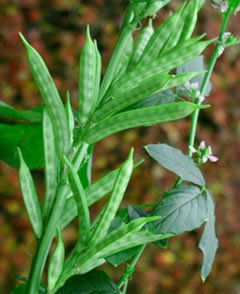Guar Gum: Unique Qualities for Art & Crafts
- Sylvia Rose

- Nov 1, 2024
- 5 min read
Guar gum is recognized for its unique natural properties in visual arts and crafting. From enhancing textures to creating custom paints, guar gum or gum guar offers many creative possibilities. The light yellow powder creates a versatile gel.

This non-toxic gel can be used as a naturally sourced additive, adhesive, glaze or texture tool. Here's some background guar gum, its origins, historical significance, economic importance, and its comparative qualities with other gums, particularly gum arabica, and incense.
What is Guar Gum?
Guar gum is a natural polysaccharide derived from the seeds of the guar plant (Cyamopsis tetragonolobus). A hydrocolloid, it functions as a thickening agent, stabilizer, and emulsifier. When mixed with water, guar gum swells, creating a gel-like consistency.
The ability to absorb water is the secret to its gel-like consistency. Guar gum in art supplies can enhance textures, glue materials, craft custom paints and coatings. Artists mix it with pigments to create smooth, sustainable paint, well adherent to surfaces.

It can be used for different artistic purposes. These include enhancing paint textures, improving fluidity of mediums, or as binding ingredients in homemade craft materials. In natural health guar gum is classified vegan.
Guar gum is processed from the guar beans to yield a white to light yellow powder mainly composed of galactomannan, a polysaccharide contributing to the impressive absorption and viscosity of gum guar. It's commonly used in the food industry for thickening.
Where Does It Come From and How Is It Harvested?
The guar plant (Cyamopsis tetragonoloba) is primarily cultivated in countries like India and Pakistan, where the dry climate is well-suited for its growth. Harvesting is a step by step process. When the pods turn brown and dry, harvesters collect the seeds.

After harvesting, the seeds undergo drying and milling to produce the fine powder for artists and crafters to use in projects.
The guar plant thrives in warm, arid environments. India and Pakistan are leading producers, contributing approximately 80% of the world’s guar gum supply. The ideal climate in these regions accommodates the plant’s growth cycle for effective cultivation.
Guar Gum History
Guar gum's history spans thousands of years, with its earliest uses traced back to ancient India. Traditionally, the beans or seeds are ingredients in many regional dishes. In the 1940s its ability to stabilize and thicken food becomes widely recognized.

In the 20th century guar gum finds a place in various industries, including food production, pharmaceuticals and cosmetics. In an environmentally conscious world its rise can be attributed to its eco-friendly properties and versatility.
Over time, guar gum's applications spread to industries like cosmetics, pharmaceuticals and textiles. Demand has surged in recent years.
Is Guar Gum Suitable for Making Incense?
Guar gum is a good binder, helping hold components together without chemicals. Guar gum also aids in achieving the desired texture and burn rate, making it suitable for both cone and stick incense. The natural composition of guar gum enhances the purity of handmade incense.

Crafters looking for natural alternatives in incense recipes may find guar gum enhances the overall quality of products. As a binder in incense recipes, helping to hold together essential oils and other components. It creates a smooth uniform texture in the final product.
Guar Gum Compared to Gum Arabic
When discussing plant-based gums, guar gum is often compared to gum arabic (acacia gum), another popular natural thickener and emulsifier. While both gums share a common purpose, they possess distinct qualities that make each suitable for specific uses.
Viscosity: Guar gum creates a thicker texture as it binds with water, whereas gum arabic yields a thinner, more flexible consistency.
Heat Resistance: Guar gum is typically more stable under heat, making it favorable for cooking applications, while gum arabic may lose its properties when exposed to high temperatures.
Flavor: Gum arabic has a neutral flavor and is often preferred in food and beverage formulations for taste applications, while guar gum can affect flavor profiles more distinctly.

In specific applications like slurry and gel-making, guar gum demonstrates superior performance due to its rapid water absorption. Studies indicate that guar gum can absorb up to 8 times its weight in water, yielding thicker and more stable textures compared to gum arabica, which works better in dry formulations.
Economic Importance of Guar Gum
With its wide-ranging applications, guar gum holds significant economic importance. The global demand for guar gum is high in the food industry, where it's a thickener and stabilizer in sauces, dairy, and gluten-free foods.
Beyond culinary uses, guar gum is also essential in the oil industry for hydraulic fracturing and in the textile industry as a thickening agent in dyeing processes. Guar gum production supports thousands of farmers and contributes to local economies, particularly in India.

The global market for guar gum has expanded impressively, with estimates suggesting a valuation of over $900 million in recent years. As businesses and consumers prioritize sustainability, demand for natural products like guar gum is expected to increase.
Facts About Guar Gum
Non-Toxic Nature: Guar gum is food-safe, making it an excellent option for artists and crafters working with edible materials.
Biodegradable: As a natural product, guar gum is eco-friendly and decomposes without harming the environment.
Versatile Applications: Beyond its use in art, guar gum plays a significant role in industries like food, pharmaceuticals, textiles, and cosmetics.
Easy to Incorporate: Guar gum can easily be mixed with various mediums, including paint, resin, clay and inks.
Water Retention: Guar gum has excellent water retention properties, beneficial in crafting projects where moisture control is necessary.

Non-Fiction Books:
Fiction Books:
READ: Lora Ley Adventures - Germanic Mythology Fiction Series
READ: Reiker For Hire - Victorian Detective Murder Mysteries


